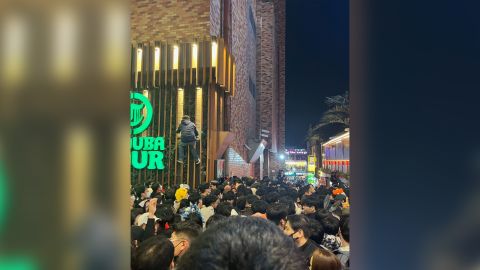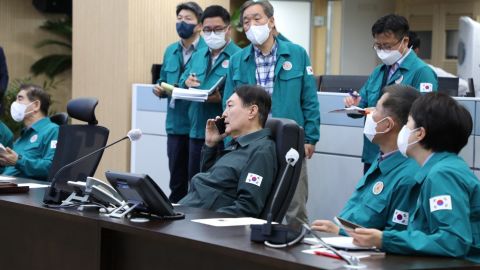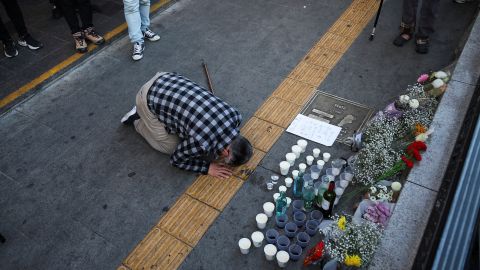CNN
—
A fresh graduate in her first full-time job; a teenager who helped raise her siblings after their father’s death; a foreign exchange student excited for his first trip to Asia.
In the seven days since 156 people were killed in a Halloween crush in the South Korean capital, the names and stories of those who died have emerged, along with details of missed warnings and desperate calls for help.
According to police emergency call logs, multiple calls were made as early as four hours before the tragedy unfolded, as the crowd in Seoul’s buzzy nightlife district Itaewon became so packed that partygoers were unable to move or breathe.
Videos taken over the course of that night show revelers realizing, at first slowly then in a rush of panic, that what was supposed to be a fun night out was spiraling dangerously out of control.
Police ultimately sent four police dispatches to the site that evening, but too few and too late to prevent the disaster.
Families are mourning the loss of their loved ones, with most victims in their teens and 20s. Amid the grief, anger has grown with demands for answers as to how things could have gone so terribly wrong.
Here’s a look back at how the disaster unfolded – and the early danger signs that went unheeded.
Halloween in Itaewon isn’t a single event held by an organizer – rather, it’s a popular place for young people, often dressed in elaborate costumes, to go bar hopping and clubbing.
From the Itaewon subway station, the main nightlife strip can be accessed via a sloping alleyway less than 4 meters wide (13 feet), that runs between the brick wall of the Hamilton Hotel and some stores. On weekends, the alley becomes a busy thoroughfare for people coming and going, giving it a convivial atmosphere where friends meet up and party.
By 4 p.m. on October 29, crowds had become “significantly big,” said Park Chang-ki, a parking attendant who worked across the road from the alley where most of the crush took place.
By 5 p.m., the alley was so packed it was completely blocked off, according to the owner of a restaurant facing the alley.
At 6:34 p.m., police received an emergency call – the first of 11 increasingly urgent calls that first pleaded for crowd control, then for rescuers.
“That alley doesn’t look safe … It feels like (people) can be crushed to death,” the caller said. “I barely escaped, I think you need to control this, there are simply too many people.”
“Police will come out and check that out,” the officer responded.
By 7 p.m., people in the alley were spilling out onto the adjacent main road, said Park, the parking attendant.
According to police logs, the second emergency call came just after 8 p.m., with the caller saying people were being pushed, falling and getting hurt. “It’s chaotic … I think it needs to be controlled somehow,” the caller said.
Similar warnings, growing more dire, soon followed.
Just after 8:30 p.m., a caller warned police the situation was “really serious.” Twenty minutes later, another caller said it felt like a “madhouse.”
“It’s not a joke. It’s not a prank call,” they said, adding: “I beg you.”
Things rapidly escalated between 8 p.m. to 9 p.m, with footage showing the Itaewon streets – lined with clubs and bars blasting music – packed with revelers standing shoulder to shoulder, some pushing forward in a slow-moving wave.
Crowds aren’t unusual for Seoul, or for the Itaewon area, which is often full of partygoers on weekends. Some experts have said this may have contributed to the disaster, with residents unaware of the danger because they were used to being in tightly packed crowds.
In a selfie video taken at 8:41 p.m., 22-year-old French exchange student Anne-Lou Chevalier and her friends laugh about the number of people as they wait in the middle of an unmoving crowd.
“At the beginning we thought it was funny,” said Chevalier. “We heard Halloween in Itaewon was amazing.”
But unease soon set in. In a video taken just minutes later, the group’s laughter has taken on a nervous edge as one girl says, “Just try not to fall.” Another responds, “I’m scared.” Shortly after, Chevalier says, they began to feel crushed; she passed out and was evacuated, with a photo taken at 8:58 p.m. that shows her being lifted away from the crowd by two men.
By 9 p.m., an emergency caller urged police to “make an emergency dispatch now,” saying a “big accident could occur at any moment.”
Several other callers around this time warned that people were being trampled on, describing the situation as “horrible.”
One caller, at 9:02 p.m., put it more bluntly: “Somebody is going to die.”
By 9:30 p.m., the streets were crammed full; some people reported not even being able to exit the nearby subway station, with new partygoers still arriving in the area.
By now, the danger was apparent. Ian Chang, a 21-year-old university student from Florida, arrived in Itaewon around 9:40 p.m., planning to meet his friend Steven Blesi, another American exchange student – but the crowds were so severe he messaged Blesi at 10:17 p.m., urging him to avoid the area.
It’s not clear if his warning ever reached Blesi – one of the two American victims who died that night, the other being 20-year-old Anne Gieske from Kentucky.
Sometime before 10 p.m., Emily Farmer, a 27-year-old English teacher in Seoul, escaped into a bar after being “overwhelmed” by the crowds. Shortly after, she said, rumors began spreading that somebody had died and patrons were not allowed to leave.
By 10:21 p.m., some began taking desperate measures; a photo shows a man scaling a wall to escape, cheered on by bystanders unaware of what was happening.

Minutes later, police began receiving reports of people being “buried” in the crowd.
“At 10:23 p.m. we received more than five reports that people fell, and they could either get hurt or die,” a first responder told CNN, speaking on condition of anonymity because they were not authorized to talk to the media.
Authorities rushed to the scene, where they saw up to “10 rows of faces – we couldn’t even see their legs,” said the first responder. They said workers pulled out the people in the bottom row first – but “when we laid them (on the ground), most of them were unconscious.”
The sheer volume of people also made it difficult for police to reach those who needed help. Video posted to social media showed people performing compressions on other partygoers lying on the ground as they waited for medical attention.
Sophia Akhiyat, an American doctor in Itaewon that night, was whisked to a side street after telling an officer she could possibly help.
“I was completely overwhelmed but I started CPR on the first body I saw,” she said. “It was so chaotic because there were so many victims on the floor, along with foot traffic and partygoers and music blasting from surrounding restaurants and clubs that had no idea what was going on.”
Adding to the confusion was the fact that most people were in costume that night – meaning some mistook police officers for fellow partygoers.
One 20-year-old eyewitness, who requested anonymity because she did not feel comfortable having her name published, said when an officer tried to direct the crowds, she heard someone ask: “Is he a real policeman?”
By 11:46 p.m., South Korea’s Yonhap News Agency had reported that dozens of people were receiving medical assistance after suffering from “cardiac arrest,” citing fire authorities. Photos show the road full of police cars, with officers cordoning off the area.
At 11:55 p.m., the Seoul metropolitan government sent an emergency alert to residents in the Itaewon area, requesting vehicles to turn away due to “an emergency accident near Hamilton Hotel.”
“Citizens, please return home as soon as possible,” it read – which would be repeated in several more alerts in the following hours.
This was more than five hours after the first emergency call had come in, with reports of the disaster beginning to circulate widely on social media.
Around 12:14 a.m., the country’s National Police Agency made its first report to agency chief Yoon Hee-keun, according to Yonhap.
President Yoon Suk Yeol dispatched a disaster medical assistance team to Itaewon, ordering hospitals to prepare emergency beds.
By 12:30 a.m., the scale of the tragedy was becoming clear, with photos showing a line of blue body bags on the street, as first responders rushed the wounded onto stretchers and into ambulances.
Just after 1 a.m., authorities released the first death toll of 59 killed as they worked frantically to transfer injured people to nearby hospitals, and bodies to multiple mortuaries.
During those early hours, the city government began receiving a flood of missing persons reports, and launched the days-long effort to identify victims.

By 6 a.m. on Sunday morning, as families across South Korea woke up to the news and began the agonizing search for their loved ones, the death toll had risen to 149.
That toll slowly ticked up over the following days as more people succumbed to their injuries, reaching the current figure of 156.
Now, the initial panic and terror of that night has transformed into nationwide devastation and calls for accountability.
On Monday, authorities said they had no protocols in place for dealing with massive crowds without a specific organizer.
Afterward, the prime minister said the disaster revealed South Korea’s “lack of deep institutional knowledge and consideration for crowd management.”

On Tuesday, the national police chief admitted the police response to the emergency calls had been “inadequate.”
“Through this incident, I feel deep responsibility for public safety and we will do our best to make sure such a tragedy as this does not occur again,” he said, announcing a special investigative team and promising transparency.
The investigation will include examining why police only made four dispatches ahead of the incident despite the high number of calls.
By Wednesday, that investigative unit raided local police stations across Seoul, seizing internal reports and documents relating to the emergency calls made that night.
Meanwhile, the chief of the Yongsan police station – responsible for the district where Itaewon is located – was suspended and replaced. The investigation is ongoing.